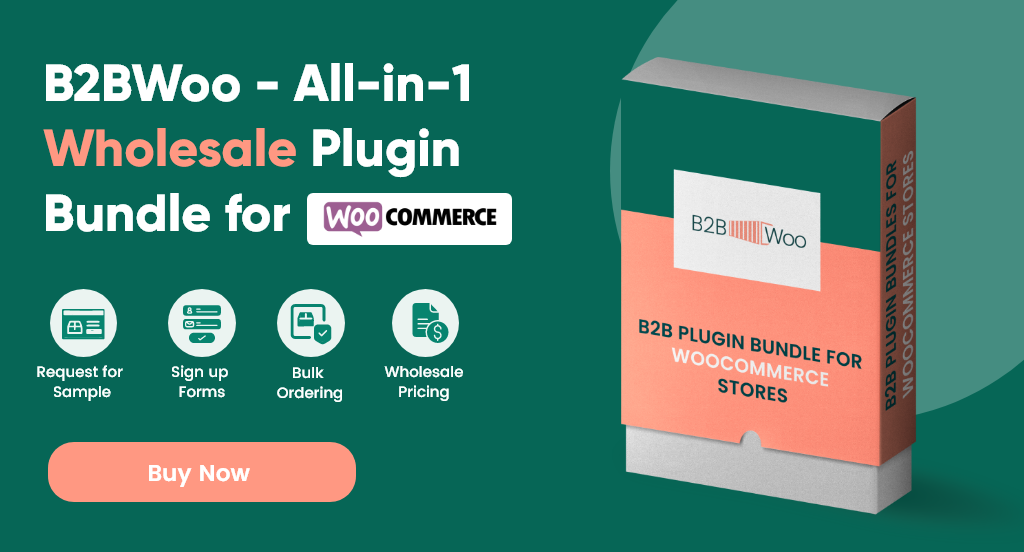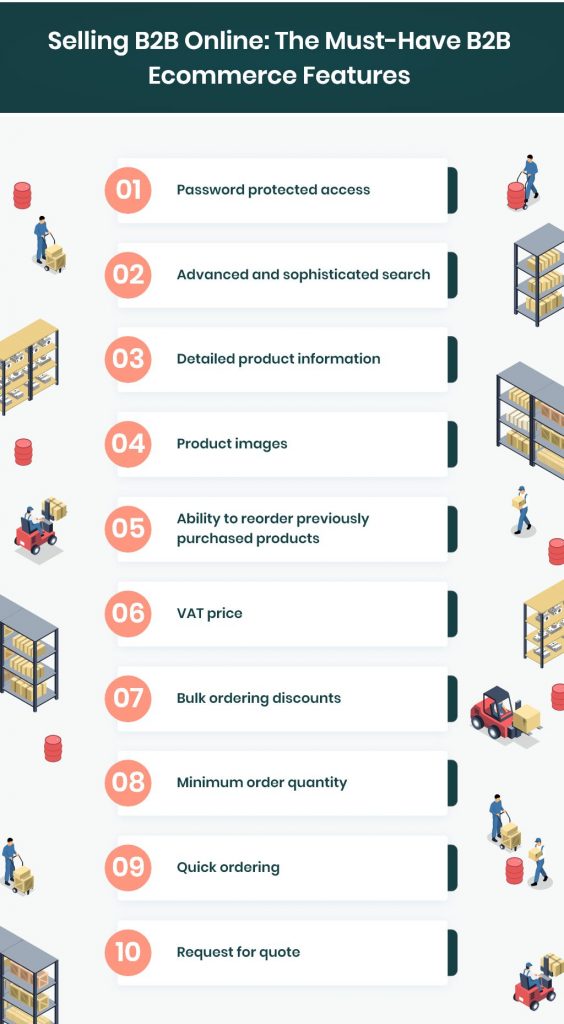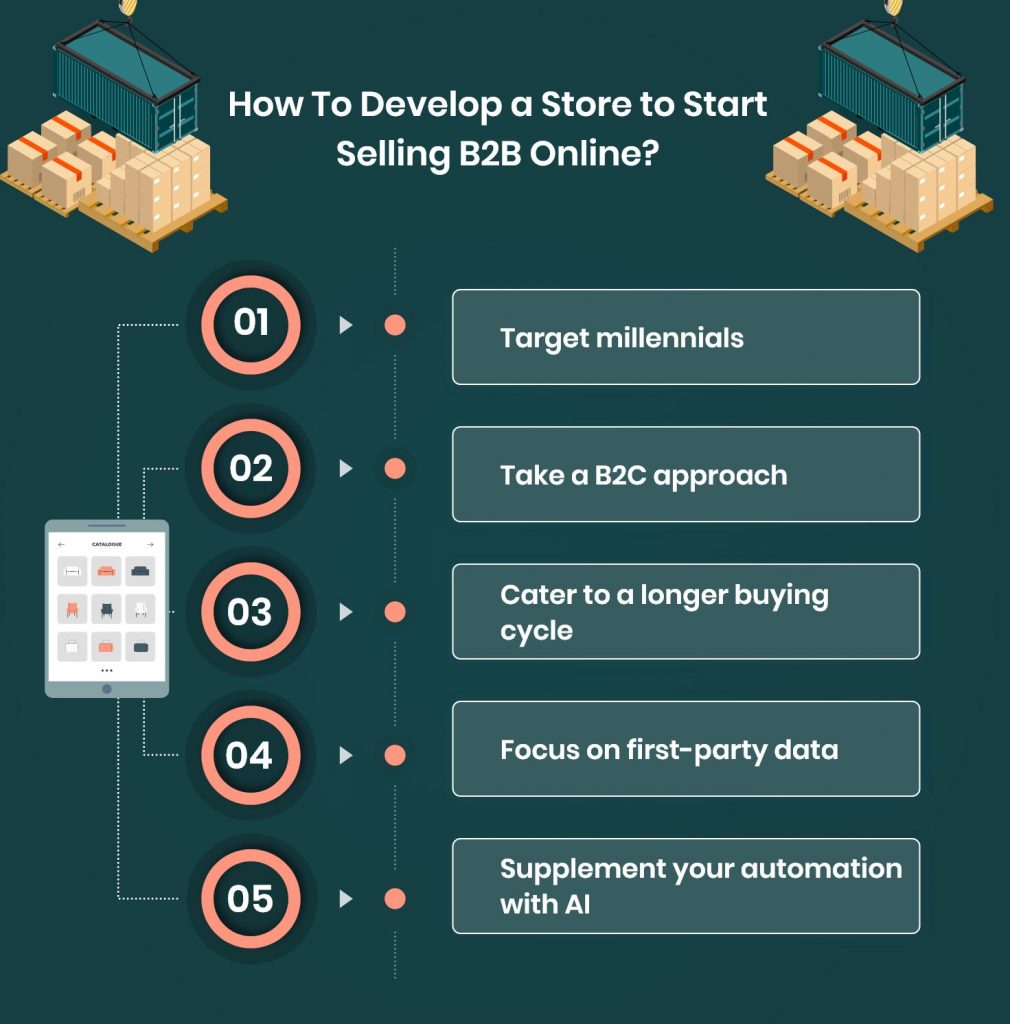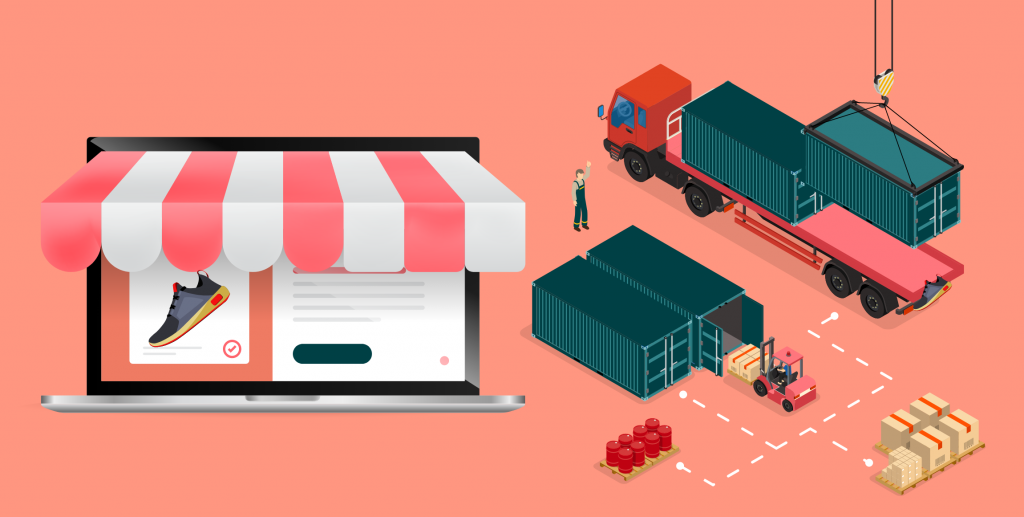The B2B eCommerce market is a land of opportunity. The reasons and motivations for selling B2B online are plenty and differ from person to person.
Yes, while the going will be tough, the returns are equally rewarding. This post is geared towards those looking to enter the B2B market.
We’ll be exploring the why, and how of selling B2B. Afterward, we’ll be discussing the various strategies you can use for a successful B2B eCommerce operation.
So, let’s begin.
Why You Need to Sell B2B Online:
B2B is a different league in and of itself. The stakes are higher and so are the returns. If B2C is the front-end of the eCommerce world, B2B is the backend that makes the magic happen.
So why should you focus on selling B2B online rather than B2C?

- Industry Size: The B2B market is huge, projecting revenues in the trillions, and a market cap that’s twice the size of its sister industry, B2C.
- Order Value: B2B eCommerce boasts an average order value of $491, which is 230% higher than B2C.
- The Millennials: This digital savvy age-group is now making headways in B2B, with buyer profiles boasting up to 80% of millennials.
- The B2C Experience: Taking cue from the B2C buyer experience, the new age groups penetrating the B2B market are now demanding B2C-esque purchasing experiences in B2B eCommerce.
- Catalogs Display: With new development technologies penetrating the market, B2B owners are innovating ways in which they show off and display their catalogs.
- Automation: With so many businesses process automation software available, it’s now become easier than ever to set up a B2B store and integrate automation systems to save time.
- Direct-to-Consumers: With enough resources, you could overhaul your business-facing model and start selling B2B online directly to consumers rather than a retailer or wholesaler.
- Supplier Management: In a growing market, there is no shortage of suppliers available. Managing all of them is a different scenario though. With the right B2B eCommerce architecture, you could manage your suppliers more efficiently.
Selling B2B Online: The Must-Have B2B Ecommerce Features

In the previous section, we tried to draw a similarity between B2C and B2B. While B2B might be taking cues from the B2C purchasing experience, there are certain features that are exclusive to B2B.
If you already know the features, you can skip ahead to the next section. That being said, there’s no harm sifting through them, is there?
Password protected access
This is the major difference between the two. B2B companies hide their product prices and only show them to logged-in and approved users.
If you’re competitive about your prices, then you can hide them from public view through the feature. In addition to that, it’s also quite effective in ensuring the security of your store.
Advanced and sophisticated search
You want to make it as easy as possible for users to sift and search through your product catalogs.
Of course, this applies to B2C products as well, but B2B requires a bit more modification depending on the product. For example, if you’re selling spare parts in bulk, you need to have specifications based on different vehicle models.
Detailed product information
In the context of B2B, product information is not just limited to a “description”. It implies a detailed description, showcasing each product feature to the tee.
Now written content is effective but well-designed images and posts can work wonders in this case as well.
Product images
You want to show detailed high-quality images of each product with its specifications. The more visually appealing you make it, the better your chances are at making the sale. Product videos and 3D-movable images are also effective, with the second one requiring more investment.
Ability to reorder previously purchased products
B2B buyers oftentimes purchase from the same product category from your store. If you have several products present, then we’d recommend giving your customers the ability to re-order products.
VAT price
For a B2B business, it’s best to have pricing toggles as both inclusive and exclusive of taxation.
Bulk ordering discounts
For buyers who purchase in bulk, it’s best to provide discounts if the situation allows. This ensures that the buyers are retained.
Quick ordering
To avoid making your buyers go through the B2B journey to purchase again and again, it’s best to add a quick order functionality to your store. This allows for quicker purchasing and check-out.
Request for quote
This B2B feature is present to inquire about a particular product. A good example of this is a B2B buyer landing on the store and asking whether or not the price is flexible.
Minimum order quantity
For a B2B business to be effective, a minimum order quantity must be met. This ensures that users can only proceed with a purchase when they have purchased a specific amount of a particular product.
How To Develop a Store to Start Selling B2B Online?

Not everyone understands the nuances of web development and programming, least of all business owners.
Yes, while the newer generation of individuals starting out with eCommerce understand it, developing an eCommerce store, or outsourcing the process, is a different story altogether.
Let’s see the ways you can develop your eCommerce store to start selling B2B.
Aligning Business and IT Goals
You need to get your priorities straight first and foremost. You want a practical solution that does what you intend to do with it.
For example, you develop a website that has all sorts of cool stuff but doesn’t let you properly manage your inventory. Business first, glitters later.
Developer Briefs
Whatever requirements you might have, it’s best to write them down. Developing a brief of your requirements, even if it’s a rough draft helps you stay on track with the project.
In the event of outsourcing, it helps the eCommerce development company to have an idea of what you want.
Use Cases
This varies depending on the niche of your product and your target customers.
For a B2B eCommerce store, I’d recommend having a B2C-esque purchasing experience, thus enabling all sorts of users to navigate the store without problems.
Selecting the right platform
This task is mountainous. You have a list of requirements, of course, and not every platform will have those. From Magento to Shopify, and WooCommerce – there are tons of platforms to choose from.
You can also go for a custom B2B solution like B2BWoo that lets you add multiple features for your business-specific needs through the WordPress platform.
Hiring a development team
If you go the outsourcing road, you will find a lot of bidders for your project. Of course, you want to select one that truly understands your business. When looking for a software development team, it’s best to check their expertise as well as their level of communication. You can get a hint of that in the first consultation, so it’s best to try to figure out their level of communication in the beginning.
Selecting a theme
The theme of your eCommerce store is a major branding concern. Of course, you want to select a theme with foresight, so you don’t have to face rebranding problems.
Integrations
Whether you add them in the beginning or at the very end, integrations are an important concern to look at. They add extra functionality. On Shopify, it comes in the form of extensions. On WordPress, it’s called Plugins.
Integrating search engine optimization
When you’ve finished the major development tasks, it’s time you give your website the ability to get exposure in search engines. SEO tools are available on every eCommerce platform and can help you target keywords for better search engine visibility.
Going live and maintenance
Your gateway to selling B2B online begins when you go live. Of course, when you go live, the website effort doesn’t stop there. You also need to constantly maintain it to ensure there are no bugs. Also, never miss out on updates to the platform, whichever one you use.
Selling B2B Online: The Various Strategies
Running a B2B eCommerce business is not just limited to having fancy technologies at your disposal. That’s only a part of it. It also includes interacting with your customers and building long-lasting relationships.
There are five basic strategies you need to look out for if you’re looking to grow your B2B eCommerce business.
Target millennials
We’ve discussed this in the first section. If you’re looking to sell B2B online, then you need to target a new brand of people entering the industry: the millennials. Gone are the days when B2B was more formal and uptight. Considering how the millennial market has expanded in B2B eCommerce, there are certain changes you have to make. These changes are, of course, in line with the preferences of the millennial buyer:
Optimize your customer support and live chat activities for speed.
Improve your mobile interface.
- Focus on social media engagement and not limit it to LinkedIn.
- Marketing your product/services with the ideas of social responsibility.
There are so many ways you can target millennial buyers on your eCommerce store.
Take a B2C approach
There is a fine line dividing B2B and B2C eCommerce from one another. But while the technicalities differ, both industries have integrated elements from each other into their own industry.
Speaking from a wholly B2B perspective, there are certain elements from B2C that you can borrow and implement on your B2B eCommerce store. Some of them include, but are not limited to:
- Increased personalization: From the landing pages to the email newsletters. Your messages must be tailored to the target audience.
- Emotional marketing: In a diverse world, simply selling B2B won’t cut it. You need to embrace social responsibility and deliver your marketing messages following those responsibilities.
- Ease of access: Your B2B store’s resources must be easy to access. Oftentimes, businesses get caught up in the red tape. To ensure that that’s not a possibility, you need to give out information, and provide it in an easy-to-use manner.
Cater to a longer buying cycle
The COVID-19 pandemic has caused a rise in buying cycles. To cater to the growing B2B buying cycles, businesses need to ensure that the buyer does not deviate from the purchase. The idea is to get the message across through:
- Content creation that doesn’t let the buyer deviate.
- ROI focused language in your marketing messages.
Focus on first-party data
Gaining an understanding of customer data is essential. It’s also important to know what eCommerce data you need to be looking at first and foremost. First-party data, data that is retrieved directly from the customer is essential in this matter since it gives you an idea of future decision making directly from the customer itself.
Supplement your automation with AI
If you’re looking to sell B2B online in an effective manner, you need to invest in business process automation. Its primary goal is to simplify repetitive tasks in your workflows. In addition to automation, you can also use AI for your data analysis purposes thus giving you effective data points for decision making.
Final Words:
The world of B2B eCommerce is diverse and full of challenges. While the profits are generally great, the effort required in getting to them is a journey by itself. The recommendations and suggestions provided in this post are here to give you a guideline. You can alter them or outright remove them from your strategies if it’s not a good fit.
If you’re a WooCommerce B2B store owner and want to enhance your productivity, then B2BWoo is the best option for you. It’s a one-stop-shop for your every WooCommerce B2B eCommerce solutions.
So, what are you waiting for? Start selling today.

B2BWoo is a complete B2B eCommerce platform built on WooCommerce that lets you create a complete B2B system on your WooCommerce store. With all the essential B2B features integrated with the platform, B2BWoo is an ideal choice for all types of businesses looking to get started with eCommerce.
